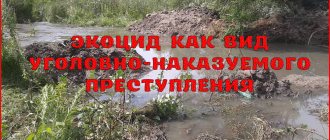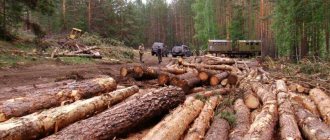During military operations to protect the environment, liability for such an atrocity as ecocide was introduced in world legal practice. This was due to the fact that during wars heavy damage was caused to the environment, causing the ecology of a particular area to suffer greatly.
After which ecocide received its legal recognition in international legal acts (Conventions, international covenants and treaties). This concept refers to actions involving large-scale destruction of flora and fauna, poisoning of atmospheric air and water bodies, and other actions that entail a change in the environmental situation in the region.
The actions of the perpetrators are aimed at eliminating or attempting to destroy the natural environment for human life. This concept first appeared in domestic legislation in 1997, when an article for genocide was introduced in the Criminal Code of the Russian Federation. The concept, types of legal liability, examples from judicial practice on ecocide, the elements of an international crime and types are presented in this article.
General information about ecocide
This crime is particularly serious in terms of severity, since it causes irreparable damage to the environment, and refers to criminal actions aimed against the peaceful and safe existence of people. Ecocide stands alongside equally dangerous crimes such as genocide, the proliferation of weapons of mass destruction, the use of illegal means of warfare, calls for participation in armed conflicts, and others.
Concept and legal norms
In Art. 358 of the Criminal Code of the Russian Federation defines the crime of ecocide. It constitutes the commission of the following illegal actions:
- mass destruction of flora and fauna;
- poisoning of atmospheric air and water sources;
- other actions that may lead to environmental disaster.
Object of encroachment
From the definition, three objects of encroachment can be distinguished:
- Tribal – relationships that ensure the safety of human life (the entire natural habitat of all living things).
- Species – relationships that ensure the environmental safety of human life.
- Direct - relationships that ensure the protection of humanity from specific dangers of an environmental nature (specific elements of nature - water, airspace, flora and fauna).
Public danger
The public danger from crime is expressed in damage to the natural living conditions of humans and all life on the planet, a stable basis for the socio-economic development of states, as well as the existing gene pool of nationalities, nations, flora and fauna. However, the definition of the main categories associated with this criminal act must be sought in other legal sources. Without special terminology, it is impossible to fully disclose the composition of ecocide.
- Large-scale destruction of flora and fauna - actions aimed at stopping the vital activity of one species or the entire set of forms of representatives of living beings and plants (complete or partial elimination).
- Poisoning of atmospheric air and water sources - actions to spread toxic and harmful substances (of chemical, biological and radioactive origin) in the atmosphere, as well as in water bodies, resulting in negative consequences for all life on the planet.
- Other activities of human activity may be associated with the production, research, experimental process of people, as a result of which preconditions arise for the onset of an environmental disaster or catastrophe.
- An environmental disaster (catastrophe) is a serious consequence for the environment that entails irreversible and dangerous changes that are significant for all living beings (a breakdown in the ecological balance in nature occurs).
Terms used
- Flora is a collection of plants growing on the territory of one state or a single area, which are interconnected depending on growing conditions.
- Fauna is a collection of species of representatives of the wild animal world that are in a free state, living in a specific area or throughout the entire country.
- Atmospheric air is the air space above the Earth’s surface, which consists of various chemical components (oxygen, nitrogen and others).
- Water resource – water sources located on the surface and underground, forming a water body, which can be used by humans for their own purposes.
Composition of a criminal act and qualification features
The totality of illegal actions included in ecocide form its objective side. It consists of three alternative actions above. Also, one of the components of the objective side is the cause-and-effect relationship, i.e. actions must lead to the onset of consequences determined in the norm - an environmental disaster.
The composition of a criminal act is formal and material. To qualify certain acts as ecocide, certain consequences must occur, which are expressed in:
- the onset of an environmental disaster;
- the cessation of the existence of certain species of flora and fauna;
- changes in the quality and composition of the atmosphere due to saturation with dangerous emissions, etc.
In addition to the occurrence of specific serious consequences for the environment, the crime can also be considered completed from the moment a real danger of the occurrence of the above results appears.
The subjective side is characterized by:
- direct intention (the perpetrator is aware of the danger of his actions and seeks to cause damage to the environment);
- indirect intention (the subject consciously allows harm to be caused to the environment or has an indifferent attitude towards the occurrence of consequences).
The subject of committing criminal acts is a general one; this can be any citizen or group of persons, regardless of their social status or position. Also, the guilty party may be a special subject: an official in the public service, as well as having military status. Age limit is 16 years. The elements of the crime do not have qualified types.
Distinction from adjacent compounds
Environmental
The closest crimes on the subject are environmental compounds, which are placed in a separate section of the Criminal Code. This category is special in relation to ecocide. Such criminal acts include:
- water pollution;
- damage to the earth;
- illegal hunting;
- actions to pollute the atmospheric air and marine environment;
- violation of the special regime established for specially protected objects of flora and fauna.
The content of these elements of atrocities is clearly environmental. Considering the object of environmental crimes, there are two types of criminal acts that encroach on:
- Environmental law and order in general. Object - legal relations related to the environment, combined into a single object of legal regulation.
- The legal order established for the protection and use of individual natural objects.
Special
In addition to purely environmental crimes, the Criminal Code provides for related compounds that perform environmental tasks only under special circumstances. Among these compositions:
- refusal to provide citizens with information;
- actions for illegal registration of transactions with land plots;
- acts of terrorism;
- illegal handling of radioactive materials;
- violation of safety rules when using dangerous and harmful substances, products, etc.
These atrocities acquire environmental meaning only when illegal actions are committed that entail a violation of the order of environmental management and, as a result, cause damage to the environment.
Ecocide is a crime against public health, and how it relates to genocide, read below.
Genocide
One of the most dangerous crimes is genocide, which has a similar object of attack to ecocide - the safe existence of all humanity. However, it has different qualifications on the objective side, which is expressed in criminal actions against humanity (destruction of human groups, causing serious harm to health, creating unacceptable conditions for existence).
Thus, the main distinction occurs based on specific criminal actions that have similar consequences - the destruction of life on Earth, be it a person, be it a representative of the animal or plant world. Read below about what ecocide as an environmental crime entails liability.
Ecocide: an impossible crime
Many may have never encountered this term before, but the Criminal Code of the Russian Federation has had an article in the Criminal Code of the Russian Federation for almost 25 years that implies liability for ecocide. However, during all this time not a single court decision was made on it.
photo: unsplash.com
Why, despite the fact that we read about environmental crimes almost every day, the word “ecocide” is excluded from law enforcement, explains our expert, lawyer Sergei Chuvilev.
As the number of environmental disasters increases, the word “ecocide” is being used more and more often, appropriately and inappropriately. Let's figure out what this word means, how it arose and how it is used.
The Criminal Code of the Russian Federation defines ecocide (from Greek οικος “house” + Latin caedo “kill”) as the mass destruction of flora or fauna, poisoning of the atmosphere or water resources, as well as the commission of other actions that can cause an environmental disaster. The punishment for this crime is severe - from 12 to 20 years in prison.
Origin
The twentieth century demonstrated that military success can be achieved not only through the physical destruction of the enemy army, but also through the destruction of resources without which war is impossible. Therefore, ecocide owes its origin, first of all, to wars.
The first use of the word “ecocide” is attributed to the American biologist, Professor Arthur Galston, who proposed, during the 1970 Washington Conference on War and National Responsibility, to develop a new international treaty prohibiting ecocide. The term caught on, and already in 1972, the then Prime Minister of Sweden Olaf Palme, speaking at the Stockholm UN Conference on the Human Environment, called the war in Vietnam ecocide.
A year later, member of the Lawyers' Commission on Nuclear Policy, John H. E. Fried, first defined ecocide as a crime encompassing "various measures of destruction and devastation... intended to damage or destroy the ecology of a specified geographic area to the detriment of human, animal and plant life." At the same time, the opinion was expressed that ecocide can take place not necessarily during a war, but also in peaceful life. The question of whether intent is a necessary element of ecocide as a crime has also generated widespread debate.
The very concept of ecocide comes from the definition of another crime against humanity - genocide, that is, the destruction of a group of people (ethnic, racial, religious, etc.). Back in 1933, Polish lawyer Raphael Lemkin formulated the concept of genocide as one of the worst crimes against humanity. Lemkin argued that genocide can occur not only physically (mass murder), but also culturally. In the latter case, the conditions of the traditional way of life of the exterminated people are destroyed, including through the destruction of nature, making living in a particular territory unbearable. An example is the policy of the North American authorities in the 19th century to exterminate bison with the aim of actual genocide of the Indians, for whom bison were the most important source of food.
Unfortunately, subsequently, under pressure from external forces, the legal definition of genocide was reduced exclusively to direct physical destruction, while cultural destruction, which is most often encountered in practice, is not prosecuted at the international level.
photo: pixabay.com
Failed international crime
At the end of the 20th century, the International Criminal Court was established, the first permanent international criminal justice body with jurisdiction to prosecute those responsible for genocide, war crimes, crimes against humanity, and military aggression. When creating this institution, it was proposed to include ecocide in its competence. However, as a result of many years of negotiations and intrigues worthy of a detective novel, the competence of the International Criminal Court included only crimes related to the deliberate destruction of nature during war. Thus, there is currently no legal ability to prosecute ecocide at the international level unless it involves war.
Social activists and environmental organizations continue to fight for the inclusion of ecocide as a crime indictable by the International Criminal Court. For example, most recently the famous Greta Thunberg donated 100,000 Euros to the Stop Ecocide Foundation, whose goal is to recognize environmental destruction as an international crime.
Situation in Russia
In Russian legislation, the concept of ecocide as a crime against the peace and security of mankind first appeared in 1996 with the adoption of the Criminal Code of the Russian Federation (Article 358). However, to date there has not been a single case known to the author of a conviction under this article.
photo: pixabay.com
In 2001, it was reported that a criminal case was opened under the article “Ecocide” regarding the mass poisoning of fry in a fishery in Kamchatka; at the beginning of 2002, the media even triumphantly reported the disclosure of this crime, but no information about the verdict could be found. The conclusion is simple: the case fell apart and did not go to trial, or the charge was reclassified to another, most likely, milder charge.
How can we explain such dislike of law enforcement officers towards the application of Article 358 of the Criminal Code of the Russian Federation? Is it really due to the absence of environmental disasters in one’s native country or a deliberate turning a blind eye to environmental crimes? It would seem that the punishment is serious, and the statute of limitations does not apply, and there are no criminal cases.
This is probably explained by the fact that the Criminal Code of the Russian Federation contains many other special crimes that have an environmental component. This is, first of all, the entire Chapter 26 of the Criminal Code of the Russian Federation (which is called “Environmental Crimes” and has 18 independent elements), as well as crimes, the rules of which are in other chapters of the Code (in particular, Articles 215 - 217, 237 , 243 of the Criminal Code of the Russian Federation). Each of these offenses is not as comprehensive as ecocide, but is usually easier to prove because it does not require establishing intent to harm nature (usually such harm is not the main goal of the offender).
So, for example, the already mentioned mass destruction of fry could be qualified, depending on the circumstances, as water pollution (Article 250 of the Criminal Code of the Russian Federation, up to five years of imprisonment) and as the deliberate destruction of someone else’s property (Article 167 of the Criminal Code of the Russian Federation, up to five years). years of imprisonment). In other words, it is often easier and more reliable to find a special corpus delicti, rather than to prove the presence of intent on the part of those whose actions led to an environmental disaster; Moreover, the last concept is also quite vague.
Then why did the legislator introduce such an obviously “dead” article into the Criminal Code of the Russian Federation (and still not remove it)? Some lawyers believe that in this way Russia, as the heir of the USSR, fulfills its international obligations. The fact is that in 1977 the USSR acceded to the New York Convention with a long title: “On the Prohibition of Military or Any Other Hostile Use of Means of Impact on the Natural Environment.”
The Convention prohibits resorting to military or any other hostile use of environmental means that have widespread, long-term or serious consequences as a means of destruction, damage or injury to any other State Party. At the same time, each state must do everything in its power to ensure that such actions are not taken on the territory controlled by such a state. Russia, as the legal successor of the USSR, has placed in the Criminal Code an entire separate article dedicated to responsibility for ecocide to prove the fulfillment of its obligations. And the fact that in 24 years there has not been a single sentence under this article is, well, apparently not fate...
Meanwhile, it seems that it is possible and necessary to apply Article 358 of the Criminal Code of the Russian Federation, especially where complex harm to nature occurs, and the scale of the consequences requires the most severe punishment.
Punishment and responsibility
Some legal scholars believe that unreasonably low sanctions are provided for this crime. Thus, the norm establishes a non-alternative punishment - imprisonment.
However, the sentence may vary depending on the circumstances of the criminal acts, the identity of the accused and other provisions - from 12 to 20 years. The severity and high danger of this crime requires the establishment of a more serious punishment, up to life imprisonment.
Arbitrage practice
Since the appearance of the norm in the Criminal Code, little judicial practice has been developed on ecocide in the Russian Federation. However, in law enforcement practice there are cases of large-scale destruction of flora and fauna. One such case is a sensational investigation in early 2002. A high-profile incident occurred in the Kamchatka Territory at one of the fishing enterprises, when illegal actions of poisoning salmon fry were recorded.
The crime took place at the end of 2001, when a group of unknown persons poured bleach into a water well. As a result, a couple of million salmon fry were poisoned. Based on this fact, a criminal case was initiated under the article “Ecocide”. During the investigative measures, the damage caused was calculated in the amount of 12 billion rubles.
Ecocide, like genocide and waging aggressive war, is a terrible crime against peace.
Ecology DIRECTORY
ECOCIDE [gr. house, dwelling + lat.sayege kill, letters, destruction of clan, tribe] - I) deliberate, criminal destruction of the habitat of all living things (life environment); 2) destruction for military purposes of the human habitat over a vast territory.[...]
Any military actions cause very significant damage to the natural environment, especially if they are carried out over a large area for a long time, however, even in short-term military conflicts, emergency environmental situations can arise if a possible enemy uses modern weapons. Deliberate human impacts on nature and the environment for military purposes are called ecocide (biocide, ecological war).[...]
During military operations in 1961-1975. In Vietnam, Laos and Kampuchea, American troops used not only chemical weapons. The “scorched earth” tactic was widely used. As a result of massive bombing, huge areas of anthropogenic badlands were formed (from the English “bad lands”). With the help of powerful bulldozers, tropical forests were cut down to the “roots” along with the soil, coastal areas were flooded, napalm (incendiary mixture) was widely used, etc. It was during the war in Indochina that A. Galsfon (1970) first introduced the term “ecocide” (environmental war).[ …]
Nowadays, various terms are used to specify the concept of “impact on nature for military purposes”: ecocide, terrorism, weather war, geophysical war, etc. However, since the final object of influence is still the living matter of the biosphere, it is advisable to use the term “biosphere war".[ …]
However, the main environmental problems that are generated by Bc are the consequences of nuclear weapons testing and military ecocide, the problems of storing and destroying chemical weapons, as well as solid and especially liquid fuel for military missiles. [...]
Significant was the oil pollution of the Persian Gulf as a result of the war in Kuwait, when Iraq blew up oil wells (see Military ecocide).[...]
The second area is the border between the PTS development zone and the retreating primary biosphere. This is an area of its fragmentation and anthropogenic ecocide, in which, with expanded anthropogenic impact, primary (homeostatic) ecosystems are destroyed, mainly in the process of expanded withdrawals of exhaustible biosphere resources: forest resources, land development and uncontrolled expansion of recreational impact. Here, frontal degradation of the primary biosphere occurs with the replacement of primary ecosystems by secondary and subsequent ecosystems in different stages of incomplete succession cycles in desertified areas after deforestation, repeated anthropogenic burning, on the remains of military bases and camps.[...]
Recognition that confrontation as a method of solving political problems and a way of enriching some at the expense of others has remained a thing of the historical past. The current unified world is like an organism with its organs. Any military confrontation is dangerous for all countries and peoples, ruinous for them, and therefore war and the threat of war is a crime against the whole world, all people, their present and future generations. It should be punishable by capital punishment as deliberate mass murder and ecocide or attempt to commit these acts. A change is required in the entire system of world law and international relations. Refusal to do this is disastrous.[...]
An environmental disaster manifests itself in a serious disruption of the ecological balance in nature, the destruction of the stable species composition of living organisms, a complete or significant reduction in their numbers, and a disruption in the cycles of seasonal changes in the biotic circulation of substances and biological processes. The motive for ecocide may be misunderstood interests of a military or state nature, or the commission of actions with direct or indirect intent. [...]
In the relatively short time of preparation and writing of the book, there was an extraordinary density of events and political and economic changes in Russia, and a lot of new information. Disclosure of data on environmental pollution, colossal damage caused by the reckless increase in dirty industrial production and the capacity of the military-industrial complex, reports of more and more territories becoming zones of environmental disaster, which gave the right to talk about “ecocide in the USSR”, an undoubted connection manifestations of environmental and economic crises - all this convinced of the need to include in educational programs the fundamentals of environmental-economic relationships and methods for coordinating the production and natural potentials of territories.[...]







